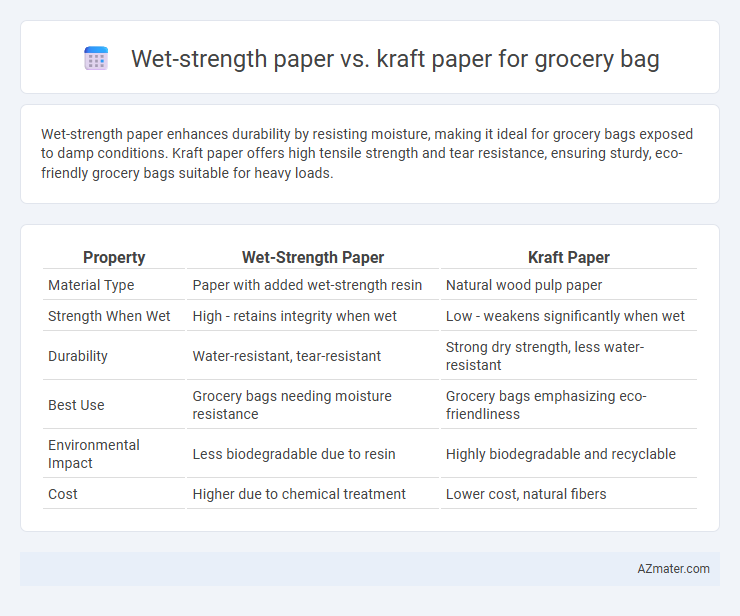Wet-strength paper enhances durability by resisting moisture, making it ideal for grocery bags exposed to damp conditions. Kraft paper offers high tensile strength and tear resistance, ensuring sturdy, eco-friendly grocery bags suitable for heavy loads.
Table of Comparison
| Property | Wet-Strength Paper | Kraft Paper |
|---|---|---|
| Material Type | Paper with added wet-strength resin | Natural wood pulp paper |
| Strength When Wet | High - retains integrity when wet | Low - weakens significantly when wet |
| Durability | Water-resistant, tear-resistant | Strong dry strength, less water-resistant |
| Best Use | Grocery bags needing moisture resistance | Grocery bags emphasizing eco-friendliness |
| Environmental Impact | Less biodegradable due to resin | Highly biodegradable and recyclable |
| Cost | Higher due to chemical treatment | Lower cost, natural fibers |
Introduction to Grocery Bag Materials
Wet-strength paper offers enhanced durability and resistance to moisture, making it ideal for grocery bags that need to carry wet or heavy items without tearing. Kraft paper, produced from wood pulp through the kraft process, is valued for its strength, tear resistance, and eco-friendly qualities, often used in grocery bags to support sustainable packaging. The choice between wet-strength and kraft paper depends on the required moisture resistance and overall bag performance in grocery applications.
What is Wet-Strength Paper?
Wet-strength paper is specially treated to maintain its durability and resistance to tearing when exposed to moisture, making it ideal for grocery bags that carry wet or heavy items. Kraft paper, derived from the kraft process using wood pulp, is naturally strong but lacks the enhanced water resistance of wet-strength paper. Choosing wet-strength paper for grocery bags improves performance in wet conditions, reducing the risk of bag failure and product spillage.
What is Kraft Paper?
Kraft paper is a robust, coarse, and strong material produced from wood pulp through the kraft process, making it ideal for grocery bags due to its durability and tear resistance. Unlike wet-strength paper, which is chemically treated to maintain integrity when exposed to moisture, kraft paper naturally offers excellent strength without additional coatings or additives. This makes kraft paper a preferred sustainable option for grocery bags requiring strength and recyclability, while wet-strength paper is suited for scenarios needing enhanced moisture resistance.
Manufacturing Processes Compared
Wet-strength paper for grocery bags is manufactured using additives like polyamide-epichlorohydrin (PAE) or melamine-formaldehyde resins during the pulp processing to enhance moisture resistance, allowing the bags to maintain integrity when exposed to water. Kraft paper production involves the kraft pulping process, which utilizes sodium hydroxide and sodium sulfide to break down lignin and produce strong, durable fibers without specific wet-strength additives, resulting in a naturally robust bag. The key manufacturing difference lies in the chemical treatments where wet-strength paper incorporates resin applications for water durability, whereas kraft paper relies on the fiber strength developed from the kraft pulping method.
Strength and Durability: A Head-to-Head
Wet-strength paper for grocery bags contains chemical additives that enhance resistance to moisture, making the bags significantly stronger and more durable when exposed to wet conditions compared to kraft paper. Kraft paper, known for its high tensile strength and tear resistance in dry environments, lacks the moisture-resistant properties, which can lead to weakened structural integrity under damp or wet use. This makes wet-strength paper the superior choice for maintaining strength and durability in grocery bags subjected to varying environmental conditions.
Moisture Resistance: Wet-Strength vs Kraft
Wet-strength paper features enhanced moisture resistance through chemical additives that reinforce fibers, making it less prone to tearing or disintegration when wet. Kraft paper, while durable and strong due to its long fibers and natural lignin content, lacks specialized treatment, resulting in lower moisture resistance and susceptibility to weakening when exposed to water. For grocery bags requiring reliable performance under humid or damp conditions, wet-strength paper provides superior protection against moisture compared to standard kraft paper.
Environmental Impact and Sustainability
Wet-strength paper for grocery bags is engineered to resist moisture, reducing the need for plastic liners and enhancing biodegradability compared to traditional plastic options. Kraft paper, made from natural wood pulp through a chemical pulping process, offers high durability and is widely recyclable and compostable, making it a sustainable choice with a lower carbon footprint. Both materials contribute to reducing plastic waste, but kraft paper's renewable sourcing and recyclability provide a stronger environmental advantage in sustainable grocery packaging.
Printability and Customization Options
Wet-strength paper offers superior printability due to its smooth surface and enhanced ink absorption, making it ideal for vibrant, detailed grocery bag designs. Kraft paper, known for its rugged texture and natural brown color, provides excellent customization options like embossing and eco-friendly printing techniques, appealing to brands emphasizing sustainability. Both materials support high-quality branding, but wet-strength paper excels in color clarity while Kraft paper offers versatile tactile finishes.
Cost Considerations for Businesses
Wet-strength paper typically incurs higher costs due to specialized resin treatments enhancing durability and moisture resistance, making it suitable for grocery bags exposed to damp conditions. Kraft paper, produced from chemical pulp, offers a more cost-effective option with strong tear resistance, but lacks water resistance without additional coatings or additives. Businesses must balance upfront material expenses against performance needs, as wet-strength paper reduces risk of bag failure and product damage, potentially offsetting higher purchase prices in wet environments.
Best Uses: Choosing the Right Paper for Grocery Bags
Wet-strength paper excels in grocery bags designed for heavy or damp items due to its enhanced moisture resistance and durability, preventing tearing during handling. Kraft paper offers superior strength and eco-friendliness, making it ideal for standard grocery bags carrying dry goods and heavier loads without exposure to moisture. Selecting wet-strength paper ensures reliability for wet or frozen products, while kraft paper is preferred for sustainability and cost-effectiveness in everyday grocery use.

Infographic: Wet-strength paper vs Kraft paper for Grocery bag
 azmater.com
azmater.com